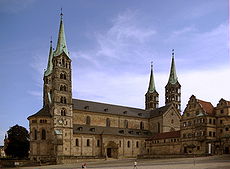
Bamberg witch trials
Encyclopedia

Bamberg
Bamberg is a city in Bavaria, Germany. It is located in Upper Franconia on the river Regnitz, close to its confluence with the river Main. Bamberg is one of the few cities in Germany that was not destroyed by World War II bombings because of a nearby Artillery Factory that prevented planes from...
in Germany
Germany
Germany , officially the Federal Republic of Germany , is a federal parliamentary republic in Europe. The country consists of 16 states while the capital and largest city is Berlin. Germany covers an area of 357,021 km2 and has a largely temperate seasonal climate...
in 1626-1631, are among the more famous cases in European witchcraft history. They resulted in the executions of between 300 and 600 people, and were some of the greatest witch trials in history, as well as some of the greatest executions in the Thirty Years War.
The Bamberg Witch Trials erupted during a period of a series of mass witch trials in the area of Southern Germany, contemporary with the Würzburg witch trial
Würzburg witch trial
The Würzburg witch trial, which took place in Germany in 1626–1631, is one of the biggest mass-trials and mass-executions seen in Europe during the Thirty Years War; 157 men, women and children in the city of Würzburg are confirmed to have been burned alive at the stake; 219 are believed to...
s and others.
The witch craze of the 1620s was not confined to Germany, but influenced Alsace, Lorraine and Franche-Comté: in the lands of the abbey of Luxueil the years 1628–30 have been described as an “épidémie démoniaque”.
The area had been devastated by war and conflicts within the Holy Roman Empire, as well as a series of crop failures, famines and plagues. Rather than blaming the politicians, people looked for supernatural explanations, and accusations of witchcraft proliferated.
Bamberg at the time was a small state ruled by the Prince-Bishop Gottfried Johann Georg II Fuchs von Dornheim, who took a leading role in the persecutions: he earned the nickname Hexenbischof or “Witch-bishop.” He was aided by Bishop Forner, who wrote a book on the subject. The prince bishop built a “witch-house,” complete with torture
Torture
Torture is the act of inflicting severe pain as a means of punishment, revenge, forcing information or a confession, or simply as an act of cruelty. Throughout history, torture has often been used as a method of political re-education, interrogation, punishment, and coercion...
-chamber adorned with appropriate biblical texts. The Bamberg witch trials have been described as possibly the worst of the period.
The bishop’s chancellor, Dr. Haan, was burnt for showing suspicious leniency as a judge. He confessed to having seen five burgomasters of Bamberg at the sabbat, and they too were duly burnt: one of them was Johannes Junius
Johannes Junius
Johannes Junius was the mayor of Bamberg, and a victim of the Bamberg witch trials, who wrote a letter to his daughter from jail while he awaited execution for witchcraft....
, whose testimony of the torture he was exposed to became famous.

